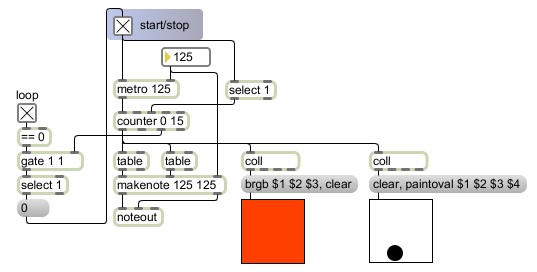Max has several ways of storing an indexed list, which programmers call an array.
table (or itable) - an array of integer numbers (with graphic display/editor)
buffer~ - an array of floating point numbers (designed for holding audio samples, but can be used for any array of floats)
coll - an array of arbitrary messages (which can be indexed with numbers or words in any order)
umenu - can be used as a popup menu or just as an array of messages
The table, buffer~, and umenu objects store their contents with numbered indexing, starting from 0, so to read through them you just need to count upward from 0. (In the coll object, you can choose the numbers and/or words you want to use for indexing.)
This program demonstrates the use of a counter to read through an array of stored data.

The metro and counter combination is just as demonstrated in the lesson on timed counting. But in this program we don't bother to show the numbers being produced by the counter. We just send them to other objects -- two table objects and two coll objects -- to look up the data that those objects contain.
The two table objects contain pitch and velocity information to play MIDI notes. (This is comparable to a 16-note pattern stored in a pattern generator in a program like Reason.) One of the coll objects contains RGB color data to describe sixteen different colors to change the background of an lcd object, and the other coll object contains position data (the left, top, bottom, and right coordinates) of a shape to be painted in the other lcd object. Double-click on the coll and table objects if you want to see their contents. The data contained in these objects was entered by hand by the programmer to describe the desired pattern of notes, colors, and positions.
This program provides a choice of whether to stop automatically when the end of the count is reached or to go immediately back to the beginning in a continuous loop. That's what's happening in the left side of the program. The gate 1 1 object is open initially (that's what the second argument means), so the counter's maximum flag (the number 1 that comes out of the third outlet when the counter reaches its maximum) will get through the gate, be detected by the select object, and turn off the metro. If we send a 0 into the left inlet of the gate, the outlet will close, the maximum flag will not get detected, the metro will continue to run, and the counter will loop back to its minimum value and continue.
To control this looping-or-stopping, we use a toggle labeled "loop". We'd like the toggle's on state to indicate "yes, looping is on", and its off state to indicate "no, looping is off". Turning looping on with the toggle will send out a 1, but what we want is a 0 to close the gate. The == 0 object makes that switch for us, because when it gets a 0 it outputs a 1, and when it gets a 1 it outputs a 0.
In this lesson we chose to use lists of note data, color data, and position data to demonstrate three different kinds of event that can be contained in an ordered array. It would also be quite easy to store an ordered list of sound files, or image files, or movie files, but we'll save that for another time.
It's even possible to store an array of arrays, or even an array of arrays of arrays. Why would you want to do that? Well, again, think of the Reason pattern generator, which stores a pattern--an array of MIDI data--in one of sixteen presets--which is an array of patterns--in one of eight banks--which are arrays of presets.
At a more advanced level, once you have written many programs that do many different things, you might want to store an ordered list of program names, to be run at the desired time, and then step through that list with a counting program.
So you can see once again that an "event" might be something as simple as a single note, or it might be something more complex like a video or a complete algorithmic process.

No comments:
Post a Comment